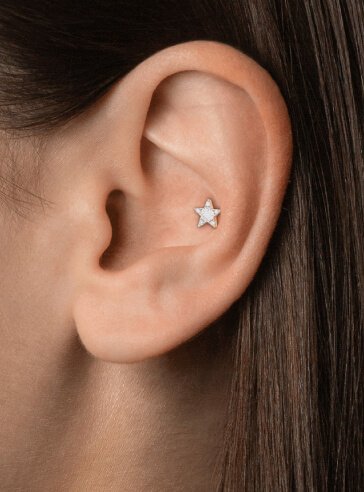Conch piercing is ear piercing on the conch cartilage. The conch is the shell-shaped structure above the earlobe. Inner and outer conch piercings are possible. The inner conch piercing is done at the core of the ear cartilage, while the outer conch is done on the conch’s edge. A hollow needle is used to make a hole in the cartilage for studs, hoops, or rings in both types of conch piercings.
Conch piercings hurt and heal slower than earlobe piercings. The average healing time is 4-12 months. Avoid touching, spinning, or immersing the piercing during healing. Recently fashionable conch piercings can be customized with ball closure rings, barbells, and labrets. Conch piercings are unique and edgy.
Jewelry for Conch Piercing: Careful Selection is Essential
Especially when it comes to piercings, picking the proper jewelry is crucial for a number of reasons. Selecting the proper jewelry is essential for a number of reasons.
- Healing process: Jewelry can help piercings heal. Surgical steel, titanium, and gold cause less discomfort and infection. Jewelry size and style also affect recovery. Too-small jewelry might tighten the piercing and prevent ventilation and healing.
- Allergies: Some people have severe allergic reactions when exposed to particular items. If you have an allergy to a certain metal or material, you should avoid wearing jewellery made from that material.
- Comfort: The correct jewellery might also help you feel at ease. The discomfort of wearing jewellery that is either too tight or too loose or that is not designed for a particular piercing. For instance, a new cartilage piercing may not be ready for a hoop earring.
- Style: Lastly, a key component of any chic outfit is the correct jewelry. Selecting the appropriate jewelry style for a piercing might help you realize your intended aesthetic goals.
Considerations for Choosing the Best Jewelry
Several factors should be taken into account while deciding on the finest jewelry for your piercing. Gauge size and material are two crucial considerations.
1. Gauge Size
The thickness of a piece of jewelry is measured in gauge size. Finding the right gauge size is essential for ease and recovery. A smaller gauge size may result in jewelry that is overly loose, causing discomfort or even inflammation.
The piercing may be stretched or even damaged if the gauge is too large. You should talk to a piercer to get advice on what gauge size would be best for your piercing.
2. Material
When it comes to healing and comfort, the substance of the jewelry makes a difference. Surgical steel, titanium, and gold are among the materials typically accepted as safe for piercings because of their low potential for causing allergic reactions or infections. Nickel and other low-quality metals have been linked to skin irritation and allergic responses.
In addition, not all piercings can be done with a given substance. Wood and bone, which are both porous and difficult to clean, may not be good options for new piercings.
Also See: The 8 Most Popular Ear Piercing for Women
Final Thoughts
The healing process and your level of comfort after getting a conch piercing are both affected by the jewelry you choose. Making the appropriate decision requires thinking about both gauge size and material.
Neither too small nor too large of a gauge size should be used in a piercing. Quality matters when it comes to your skin, so be sure the fabric is appropriate for your complexion.
Other considerations include aesthetics, craftsmanship, and durability. Piercings heal faster and feel better when you wear jewellery that complements your individual style and is made for piercings.
It is recommended that you seek the advice of a piercer or trustworthy jewelry retailer before choosing jewelry for your conch piercing. The right jewelry can help you heal faster and reduce the risk of complications after getting a piercing.



